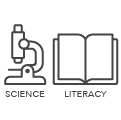Standards + Practices
DCI: LS2.A Interdependent relationships in ecosystems
ESS3.C Human impacts on earth systems
SP2: Developing and Using Models
Throughout the year, students have added observation data to their School Grounds Map model which has allowed them to better understand features of their campus. Students continue to work on revising this model to represent an improved habitat for ladybugs.
SP6: Constructing Explanations
Students continue to use evidence to support their explanations regarding the presence of ladybugs and improvements to their school grounds.
SP8: Obtaining, Communicating, & Evaluating Information
Students create presentations to communicate what they have learned with a broader audience, allowing them to see the importance and impact of sharing scientific findings.
Resources + Supports

Participation Makes an Impact!
Celebrate and share what you’ve learned! You’ve completed a year of scientific research and have contributed to the iNaturalist Ladybugs at School project, which can help others better understand how and why populations of native ladybugs have declined in North America. Along the way, you have learned so much about data collection, asking questions, repeated searches, and more. You are stewards of the ladybugs in your schoolyards, and your participation has made an impact!
Now that students have been collecting data throughout the year and sharing data with others, the class can answer the overarching questions:
How does the presence of ladybugs change across the school year? What might explain those changes?
- Which species of ladybugs do we find at our school? Are they native, non-native, or both?
- What features of our school grounds make the space habitable/uninhabitable for native ladybugs?
How can we improve habitat for ladybugs in our schoolyard?
Students will refer to these answers to the two overarching questions and the evidence used to answer them as they develop presentations.

Ms. Jones’ Class Celebrates Their Contributions to Ladybugs at School
As her class wraps up their year of participation in Ladybugs at School, Ms. Jones wants to make sure that her students recognize the importance of their contributions to the project. To help her students take stock of what they have learned this year, Ms. Jones facilitates a conversation around how students’ predictions have changed over time, asking students to describe what led to these changes. Next, they decide to share what they have learned this year with their principal. Her students are excited about the opportunity to help others in the school understand how to protect and attract ladybugs on their campus. Ms. Jones highlights that what they are doing is similar to how professional scientists work, emphasizing that science builds on the knowledge of others to develop better understanding over time.
Ms. Jones also hopes this experience may encourage her students’ future participation in Ladybugs at School or other participatory science projects. She asks the students to reflect on how they felt the first time they had a search where they found no ladybugs. Students reply that they were “disappointed” or “discouraged.” Ms. Jones asks how they felt more recently when they went out searching on a warm afternoon, a day when they expected to find many but found no ladybugs. One student says, “I was curious to know why they weren’t there.” Ms. Jones adds, “Scientists are curious about this too. They combine our data with data from many others to study it and share what they are learning about a wide range of ladybug species and their habitats. With these data available, they will have more data than they could have ever collected on their own.”
A student asks if Ms. Jones’ class will participate the following year, and she indicates, “That’s the plan because imagine how interesting it will be to see how what we observe changes from year to year and think about what might be causing those changes.” Another student chimes in, “I want to come back and help!” Ms. Jones informs students that there are many ways they can help, either continuing efforts on their own outside of school, or thinking about how to share what they have learned with other students or community members. Some students express interest in attracting more ladybugs to the school grounds for next year’s class. Ms. Jones talks with the whole class about how they would do that and then suggests they work on a class presentation for the principal that shares their ideas. She sets aside a few days of science instruction after state testing for them to work on the presentation.

Presenting Findings
Throughout the year, students have been gathering and making sense of data about ladybugs. During this activity, they will have the opportunity to apply what they have learned to present on what they have learned about their school grounds, the presence of ladybugs, and/or proposed improvements. These ideas could connect to standards covered throughout the year and to the authentic audience your class will be presenting to. Presentations may include details about:
- habitats that attract ladybugs
- characteristics of ecosystems where ladybugs are easily found
- the relationship between the ladybugs and plants they prefer
- the relationship between the abundance or lack of aphids, or other insects, for ladybugs to eat
- the relationship between the abundance of ladybugs and weather
- the use of pesticides on an ecosystem and their effect on the abundance of ladybugs
- the prevalence of native and non-native species of ladybugs in different microhabitats
- the prevalence of native and non-native species of ladybugs in different seasons
Assist students in generating ideas for how to present the information they have chosen to share. Encourage students to draw on what they have learned over the course of the year to help them make sense of the data and design a presentation. The following list provides ideas for how students might present their findings and to whom they might present.
Ideas for Presentations:
- School Specific Field Guide
- Infographic
- News report
- Written report
- Poster Presentation with key points
- Podcast or other audio recording
- PowerPoint or Slides presentation
Ideas for an authentic audience:
- Groundskeepers
- Master gardeners or school garden committee
- A younger grade
- Parents
- School administrators
- Local officials
- Park representatives
- Local college Entomology club or Entomology/Science majors
- Students from another school
- Local chapters of conservation organizations such as the Nature Conservancy (a Google search using for Ohio Environmental Organizations generated this list: http://www.eco-usa.net/orgs/oh.shtml)
- Local chapters of social-philanthropic groups such as Kiwanis (local Kiwanis chapters have been involved in some of our participatory science efforts)

Mathematics Connections
Some of the math skills and content that students have acquired throughout the year while making sense of ladybug data will help support their investigation. Students may rely on their understanding of any combination of the following:
- Recognizing when questions asked yield categorical or numerical data
- Identifying relevant and irrelevant data in the context of an investigation question
- Checking answers to questions for reasonableness
- Recognizing the total number of ladybugs observed as a separate but related data point to the variation of ladybug species
- Using place value concepts to order, compare, add, and subtract whole numbers
- Recognizing the variability of data collected between different school sites
- Using coordinates on the School Grounds Map to pinpoint locations
- Considering, explaining, and evaluating the relationship(s) between two or more variables
- Using data as evidence for explanations
- Considering alternative explanations for patterns in data (Is your explanation the only explanation?)
Various tools can help support students as they investigate and consider meaningful ways to present their thinking. The following list provides suggestions for tools that could aid students throughout their investigations:
- Graph paper, pencil, ruler (to assist with accuracy and creating intervals)
- Google Sheets
- Excel Spreadsheets
- Other representations that students are comfortable with (e.g., PowerPoint, Google Maps)

Supporting Student Data Collection
The end of the school year is a great time to have your current students introduce the project to the rising 5th graders as a way to build excitement and enthusiasm for continuing the project in the following year. Consider revisiting the Outdoor Learning Protocols and having your students demonstrate to the incoming class what it looks like to learn outdoors.

Sample Rubric
Students’ topics, presentation styles, and audiences will vary, but it will be important to determine what their presentations demonstrate about their understanding and reflection of their contributions to this participatory science project. A sample rubric is provided below.
| 1 (Fair) | 2 (Good) | 3 (Strong) | |
| Reflection Topic | I can identify different ideas I have learned about through Ladybugs at School this year. | I can explain one topic in detail that I have learned about through Ladybugs at School. | I can choose a topic I have learned about through Ladybugs at School that requires me to use data as evidence to explain the topic. |
| Data as Evidence | I have included data in my presentation. | The data included in my presentation provide evidence for some of my ideas. | The data included in my presentation were chosen to provide evidence for different aspects of the topic I chose to explain. |
|
Data Collection Reflection |
I have included information about how and when some of the ladybug searches were conducted. | I have explained how the way ladybug searches were conducted could impact collection data. | I have explained how confident I am in my ideas based on the way ladybug searches were conducted and included instances when ladybugs were not found in a way that explains the importance of zeroes. |


 s and contact the audience as appropriate. (For example, if presenting to another class, set a date/time with that teacher; if presenting to school groundskeepers, contact them to arrange a date/time for the presentation; if creating a school-specific field guide, consider materials needed, etc.)
s and contact the audience as appropriate. (For example, if presenting to another class, set a date/time with that teacher; if presenting to school groundskeepers, contact them to arrange a date/time for the presentation; if creating a school-specific field guide, consider materials needed, etc.)